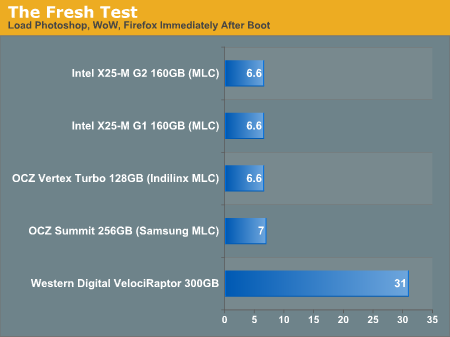Seagate Enters the Enterprise SSD Market with Pulsar
by Anand Lal Shimpi on December 7, 2009 11:59 PM EST- Posted in
- Storage
Preface to Pulsar: Why Seagate Needs This
To say that the SSD revolution caught the HDD makers off guard would be an understatement. With the exception of Samsung, none of the players in the HDD business have an even remotely competitive SSD.
Sitting this one out isn’t an option. In the enterprise market, a handful of SSDs can easily outperform dozens of 15,000 RPM hard drives. And when I say outperform, I mean by an order of magnitude.
It’s not just about performance, there’s a tremendous power advantage as well. The best SSDs use less than 3W per drive under full load. The fastest 15K RPM SAS drives gobble up a good 7W per drive. In a datacenter with thousands of servers, the power savings alone are enough to make the switch.
I use servers as my first example because the cost isn’t as touchy of a subject there, but the advantages in desktop and notebook PCs are more than tangible. Again, the key words are order of magnitude: SSDs are worth their weight in gold if performance matters to you.

The Fresh Test, Why You Absolutely Need an SSD - The SSD Relapse
Two years ago the argument was that the technology wasn’t mature enough. Intel changed all of that with the X25-M and X25-E. Even today companies like OCZ are using Indilinx’s Barefoot controller to compete everywhere from mainstream PCs to high end servers.
PCIe cards based on SSD controllers with tons of NAND flash are the next frontier for the technology. Why deal with the current SATA bottlenecks when you can push close to a Gigabyte per second of data over some PCIe lanes?
Performance and power data aside, Gartner expects SSD sales to hit $1 billion in 2010. Like I said, sitting this one out isn’t an option.
Earlier this year Western Digital acquired SiliconSystems for $65 million and rebranded their drives. Western Digital’s true attempt at a competitive SSD won’t come until sometime next year as even the latest WD Silicon Power III isn't very competitive.
Seagate has been the quiet one, until today that is. Today Seagate is announcing that it is shipping its first SSD to OEMs. The drive is called Pulsar and this is a render of what it looks like (if it appeared in front of a star apparently):











52 Comments
View All Comments
semo - Friday, December 11, 2009 - link
try doing the above simultaneously. HDDs are not good at multitasking.AnnonymousCoward - Friday, December 11, 2009 - link
That's what the "Fresh Test" is. 4.7x.DukeN - Wednesday, December 9, 2009 - link
http://www.computerworld.com/s/article/9141627/Mic...">http://www.computerworld.com/s/article/...unces_it...This could be good
AnnonymousCoward - Thursday, December 10, 2009 - link
I thought they had a joint Flash venture with Intel, so now they will be competitors?Genx87 - Wednesday, December 9, 2009 - link
Once WD and Seagate enter the markets we may see these things start approaching Raptor like pricing. Which is good enough for enthusiasts. And eventually filter these things closer to mechanical drives.strikeback03 - Wednesday, December 9, 2009 - link
They already provide a much greater boost for the additional cost over standard HDDs than the Raptors do.ClagMaster - Tuesday, December 8, 2009 - link
I am not sure it is wise to write an article about SSD performance when the author does not have the actual article in his hands that he can personally test. Then, he can precisely tell us the make of the controller, its efficiency, and the true performance of the Pulsar SSD. Until that happens, I respectfully submit that most of this article is conjecture. I wish more concrete facts about this SSD were published.I think its great that Seagate is advancing the capacities of the Enterprise SSD over that of the Intel X25 products with the Pulsar. Even though its OEM, this drive will soon make its way to Newegg (which sells plenty of OEM products) to the hands of consumers. We need information ASAP on this product.
However, I think Seagates behavior with the Pulsar Enterprise SSD says a lot about its confidence with this product. Surely Mr Shimpi certainly pulls enough weight as a credible hardware reviewer to be entrusted with an Engineering Sample prototypical of the actual OEM product to perform performance testing.
After Mr Shimpi's dealings with OCZ last March with the Vertex(leading to his most excellent article on SSD performance), perhaps Seagate is afraid of what Mr Shimpi might uncover with the Pulsar.
Casper42 - Tuesday, December 8, 2009 - link
So it seems to me that they are simply using the same size NAND modules and then amping things up using parallel channels.2 channel / 50GB
4 channel / 100GB
8 channel / 200GB
I am wondering if there is a reason why they didn't make a 6 channel / 150GB model as this would be a direct competitor (based on size only) to the standard 146GB SAS drive that are found in MANY Enterprise servers.
notty22 - Tuesday, December 8, 2009 - link
I'm curious that if after 5 years, performance had degradaed enough to warant retiring s 50 gb drive. If you wrote data say precious pictures and stored the drive, would they be there 5 years later, say 10-20 ?mcnabney - Tuesday, December 8, 2009 - link
From the article:"...but perhaps Seagate has input into the firmware design."
Ah hah hah hah hah